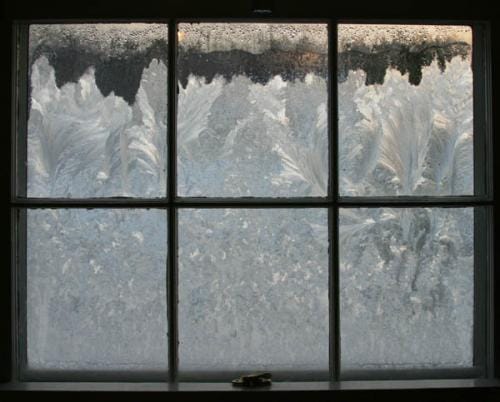What Is Condensation?
Is your Window glass “sweating” in the winter . Is water beading or ice forming on the inside surface of your windows?
Don’t be too quick to blame the windows! There’s a good chance that what you are seeing is condensation,
a sign that there is excess humidity in your home. Humidity – water vapor mixed with air – is drawn to
the coolest surfaces, such as your window. Condensation problems arise because air can hold only a limited
amount of water vapor at any given temperature. Cold air can hold less water than warm air.
Cool air cannot hold as much moisture as warm air, so windows and doors often collect this moisture and make it visible.
Sources of moisture
The principal sources of water vapor in today’s homes vary with lifestyles but the following is just a small list
of normal daily activities and the water vapor they introduce per day.
| Cooking (three meals a day) | 3-4 lbs |
| Dishwashing | 1-2 lbs |
| Shower or Bath | 1-2 lbs |
| Weekly Laundry | 30 lbs |
| Occupancy (family of four) | 12 – 15 lbs |
What Can we do to reduce moisture in our home
More and more of us are living in “air tight” homes, they are more economical to heat and cool and easier to keep clean but we
have created another problem and that is lack of air exchange and moisture traps. Since the moisture levels are not able to
escape we must take steps to reduce humidity in our home
Reduce Moisture Sources
- Stop or severely limit the use of humidifiers, or adjust them to the appropriate setting
- Run a dehumidifier if needed.
- Limit plants, aquariums, and pets. If you have a lot of plants, don’t overwater them and you should
put them in a sunny area. - Make sure that your clothes dryer is properly vented outside.
- Malfunctioning gas appliances can deliver excessive water vapor into the air along with more dangerous
contaminants. So have your appliances check regularly - Eliminate plumbing leaks.
- Don’t air-dry clothes indoors.
Increase Ventilation
- Open your windows everyday for a few minutes , particularly after steam-producing activities
such as showering/bathing, laundry, and cooking. You will only loose a small amount of heat - Run kitchen, bathroom, and other fans longer and more often.
- Improve or add a ventilation system in your home through attic, roof and soffit venting.
- Open blinds and drapes. Heavy window coverings restrict the flow of warm air over the interior glass surface.
- Operate ceiling fans to improve air circulation in your home
In most cases you can reduce window condensation by addressing high humidity and condensation through
reducing the amount of humidity generated in your home. By providing your home with the proper level of humidity,
you are on your way to providing healthier Indoor Air Quality in your home.






